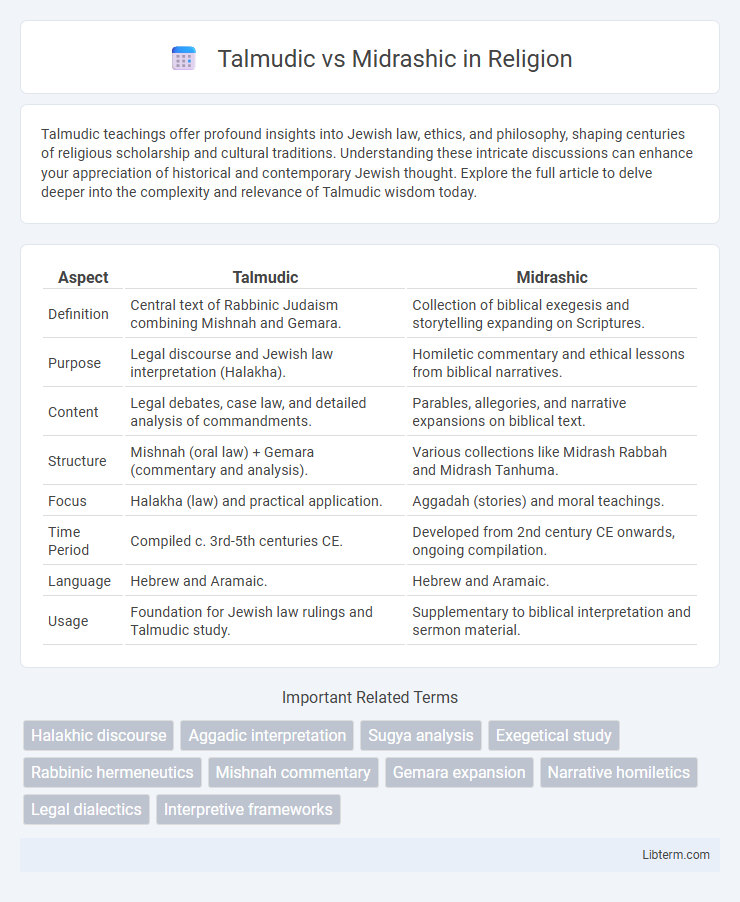Talmudic teachings offer profound insights into Jewish law, ethics, and philosophy, shaping centuries of religious scholarship and cultural traditions. Understanding these intricate discussions can enhance your appreciation of historical and contemporary Jewish thought. Explore the full article to delve deeper into the complexity and relevance of Talmudic wisdom today.
Table of Comparison
| Aspect | Talmudic | Midrashic |
|---|---|---|
| Definition | Central text of Rabbinic Judaism combining Mishnah and Gemara. | Collection of biblical exegesis and storytelling expanding on Scriptures. |
| Purpose | Legal discourse and Jewish law interpretation (Halakha). | Homiletic commentary and ethical lessons from biblical narratives. |
| Content | Legal debates, case law, and detailed analysis of commandments. | Parables, allegories, and narrative expansions on biblical text. |
| Structure | Mishnah (oral law) + Gemara (commentary and analysis). | Various collections like Midrash Rabbah and Midrash Tanhuma. |
| Focus | Halakha (law) and practical application. | Aggadah (stories) and moral teachings. |
| Time Period | Compiled c. 3rd-5th centuries CE. | Developed from 2nd century CE onwards, ongoing compilation. |
| Language | Hebrew and Aramaic. | Hebrew and Aramaic. |
| Usage | Foundation for Jewish law rulings and Talmudic study. | Supplementary to biblical interpretation and sermon material. |
Introduction to Talmudic and Midrashic Literature
Talmudic literature comprises the Mishnah and Gemara, forming the foundation of Rabbinic Jewish law and interpretation through rigorous legal discussions and debate. Midrashic literature, on the other hand, focuses on biblical exegesis, storytelling, and homiletic teachings aimed at uncovering deeper meanings within the Hebrew Scriptures. Both genres serve complementary roles in Jewish tradition, with Talmudic texts emphasizing legal principles while Midrashic works enrich scriptural understanding with narrative and ethical insights.
Defining the Talmud: Structure and Purpose
The Talmud is a central Jewish text composed of the Mishnah and the Gemara, serving as a comprehensive legal and ethical codex that interprets and expands upon Hebrew Bible laws. Its dual structure includes the Mishnah, a concise compilation of oral laws, and the Gemara, an analytical commentary that elucidates the Mishnah through dialectical discussion among rabbis. The purpose of the Talmud is to provide authoritative guidance on Jewish law (Halakha), ethics, customs, and history, shaping daily religious practice and communal life.
Exploring Midrash: Origins and Forms
Midrash originates from the Hebrew root "darash," meaning to seek or inquire, and serves as a method of interpreting biblical texts through homiletic storytelling and legal analysis. Its forms include Midrash Aggadah, which explores ethical and theological themes through narrative expansion, and Midrash Halakha, which focuses on legal exegesis to clarify and develop Jewish law. Midrashic literature emerged during the early centuries of the Common Era, providing a dynamic framework for understanding scripture beyond its plain meaning.
Historical Development of Talmud and Midrash
The Talmud evolved between the 3rd and 6th centuries CE as a comprehensive legal and ethical commentary on the Mishnah, reflecting the oral traditions and rabbinic debates critical to Jewish law. Midrashic texts, emerging earlier around the 2nd century CE, primarily explore biblical narratives through homiletic and exegetical interpretations, providing moral insights and theological explanations. While the Talmud emphasizes legal discourse and practical applications, Midrash captures imaginative expansions on scripture, both shaping Jewish thought across centuries.
Methods of Interpretation: Talmudic vs Midrashic Approaches
Talmudic interpretation relies on rigorous dialectical reasoning, emphasizing legal analysis through questioning, debate, and the reconciliation of contradictory texts, while Midrashic methods utilize narrative expansion and allegorical explanations to explore ethical and theological themes. The Talmud employs precise logic and case law to elucidate Halakhic decisions, whereas Midrash focuses on homiletic storytelling to derive moral lessons or deeper scriptural insights. Both approaches reflect distinct hermeneutic frameworks: Talmud aims for jurisprudential clarity, and Midrash seeks imaginative biblical exposition.
Key Thematic Differences in Content
Talmudic texts primarily focus on legal analysis, outlining detailed interpretations of Jewish law (Halacha) and practical applications, while Midrashic literature centers on narrative expansion and moral lessons drawn from biblical stories. The Talmud engages deeply with dialectical debate and case law, emphasizing jurisprudential clarity. Midrash, on the other hand, enriches scriptural understanding through allegory, ethical teaching, and theological exploration.
Linguistic and Stylistic Characteristics
Talmudic texts exhibit a dialectical style characterized by intricate legal reasoning, layered argumentation, and concise halachic language emphasizing precision and debate. Midrashic literature employs a narrative and homiletic approach, characterized by rich metaphorical language, allegory, and expansive storytelling that elucidates biblical verses. Linguistically, Talmudic discourse integrates Aramaic alongside Hebrew, using technical terminology, while Midrashic writings favor a more poetic, idiomatic Hebrew style aimed at moral and theological interpretation.
Influence on Jewish Law and Theology
Talmudic texts, comprising the Mishnah and Gemara, serve as the central legal authority in Rabbinic Judaism, systematically analyzing and elaborating on mitzvot to establish binding Halakhah. Midrashic literature primarily focuses on biblical interpretation and theological exploration, providing insights and narratives that enrich Jewish thought without direct legal application. The Talmud's rigorous legal discourse shapes Jewish law's practical observance, while Midrashic traditions influence theological perspectives and ethical teachings within Judaism.
Notable Figures and Texts
The Talmudic tradition is exemplified by prominent sages such as Rabbi Akiva and Rabbi Judah the Prince, whose contributions shaped the Mishnah and Gemara as core texts. In contrast, Midrashic literature features notable figures like Rabbi Eleazar and Rabbi Ishmael, who compiled interpretive stories and homiletic teachings found in works such as Midrash Rabbah and Midrash Tanhuma. Both corpora serve distinct roles in Jewish scholarship, with the Talmud emphasizing legal discourse and the Midrash focusing on narrative exegesis.
Lasting Impact on Jewish Tradition and Scholarship
Talmudic discourse shapes Jewish law (Halacha) through rigorous dialectical analysis, serving as the foundation for rabbinic decision-making and legal codification. Midrashic literature enriches Jewish tradition by offering narrative interpretations and ethical teachings that deepen scriptural understanding and cultural identity. Together, Talmud and Midrash sustain a dynamic continuum of Jewish scholarship, influencing religious practice and intellectual inquiry across generations.
Talmudic Infographic

 libterm.com
libterm.com